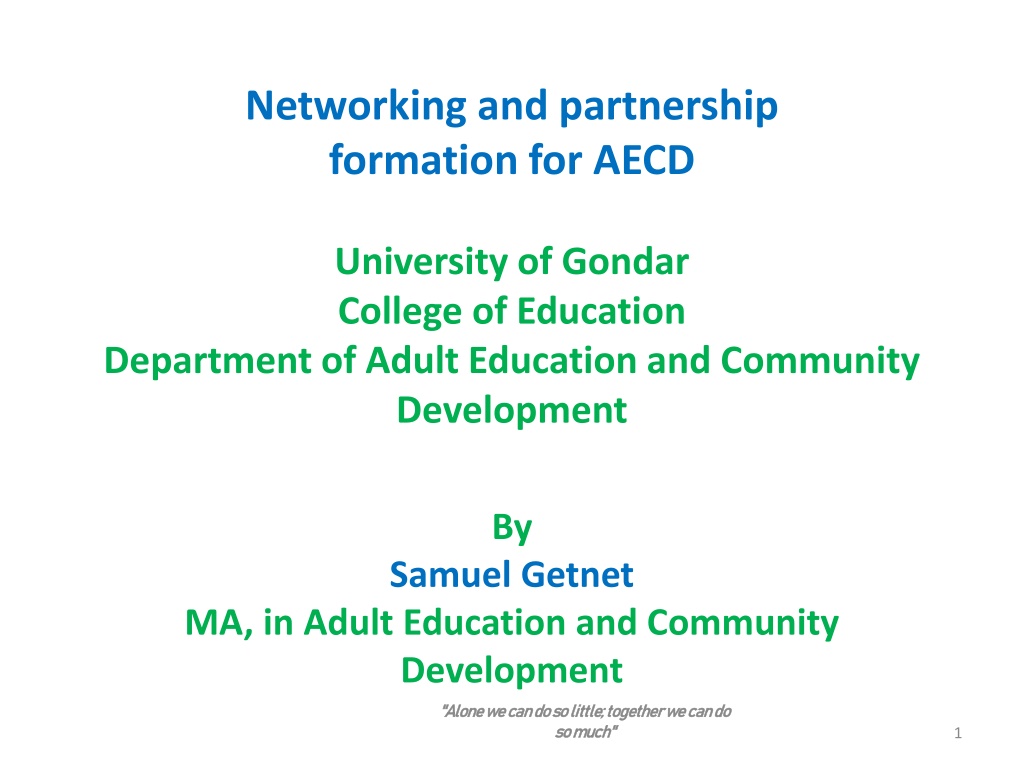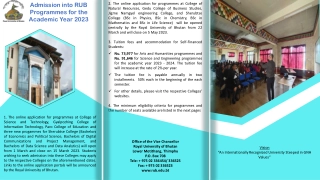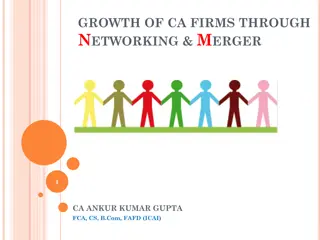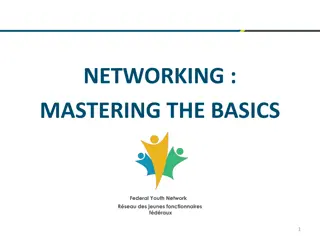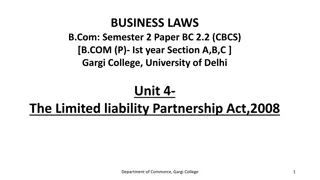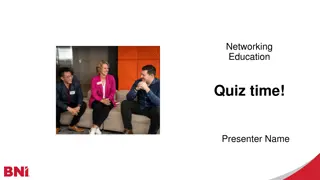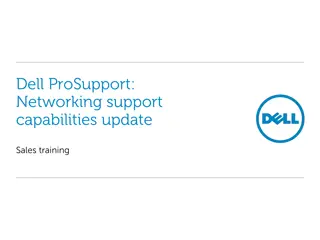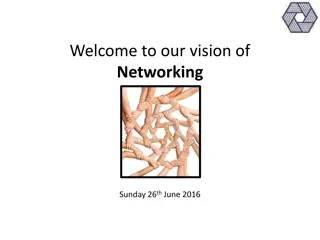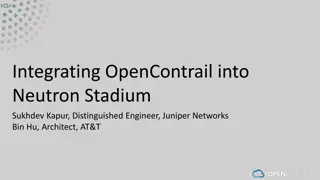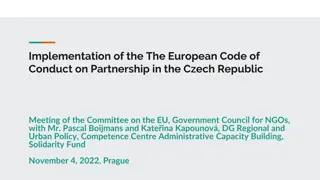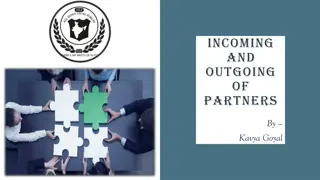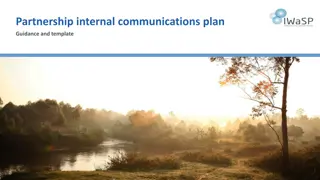Networking and Partnership Formation for AECD at University of Gondar College of Education
Networking and partnership formation are vital for Adult Education and Community Development (AECD) at the University of Gondar, emphasizing the power of collaboration and interdependence. Various concepts such as interdependence, independence, and dependence underscore the importance of working together. The principles of networking highlight the value of giving more than you get, being genuine, and taking a long-term, proactive approach. These principles serve as a foundation for successful networking endeavors in the field of AECD.
Download Presentation

Please find below an Image/Link to download the presentation.
The content on the website is provided AS IS for your information and personal use only. It may not be sold, licensed, or shared on other websites without obtaining consent from the author. Download presentation by click this link. If you encounter any issues during the download, it is possible that the publisher has removed the file from their server.
E N D
Presentation Transcript
Networking and partnership formation for AECD University of Gondar College of Education Department of Adult Education and Community Development By Samuel Getnet MA, in Adult Education and Community Development "Alone we can do so little; together we can do "Alone we can do so little; together we can do so much" so much" 1
Basic concepts Interdependence Independence Dependence "Alone we can do so little; together we can do so much" 2
"Alone we can do so little; together we can do so much" 3
Nature by itself teach us the interdependent reality "Alone we can do so little; together we can do so much" 4
Networking Networking is the exchange of information and ideas among people with a common profession or special interest information, contacts or experience. "Alone we can do so little; together we can do so much" 5
Principles of Networking 1. Give more than you get Networking is a two-way street. There is nothing wrong with wanting to get something positive for yourself out of your networking efforts, but it s important to take an approach that will also benefit others in your network. When you want to strengthen a relationship with someone in your network, and connect for the first time with someone, think about ways that you could help them "Alone we can do so little; together we can do so much" 6
2. Be genuine It s important to be genuine in your networking efforts, and really make an effort to get to know the people that you want to connect with. "Alone we can do so little; together we can do so much" 7
3. Be proactive 4. Take a long-term approach Building a strong network, takes time. The real value of those efforts will be seen in time. "Alone we can do so little; together we can do so much" 8
5. Prioritize quality over quantity It s not important that you have thousands of people in your network. What is much more important is the quality of those connections. "Alone we can do so little; together we can do so much" 9
6. Be approachable make sure that whether others are able to easily reach out to you. "Alone we can do so little; together we can do so much" 10
7. Set aside time for networking it should be a part of your daily, or at least weekly, schedule. "Alone we can do so little; together we can do so much" 11
Inter-sectoral arrangements Partnership vs. collaboration Different concepts, often perceived similarly Both implies relationships But level of relationship between or among parties is different "Alone we can do so little; together we can do so much" 12
Collaboration: Contractual agreement not required No equal share of rewards and risks Often partners have not equal accountability "Alone we can do so little; together we can do so much" 13
Partnership: contractual agreement between or among partners Equal share of risks and rewards High accountability "Alone we can do so little; together we can do so much" 14
What is partnership? "Alone we can do so little; together we can do so much" 15
Partnership arrangement by at least two independent agencies or sectors which have common interests for working together to achieve a shared purpose, for example, to wipeout illiteracy so that each sector benefits from the return from the literate adult work force. is the purposeful collaborative "Alone we can do so little; together we can do so much" 16
Why partnership? "Alone we can do so little; together we can do so much" 17
It enables to make services more accessible and effective by avoiding duplication of efforts and reduction of (Mattessich & Monsey, 1992). Specifically, It resulted in; improved decision-making, improved problem-solving, broader information/perspective on system issues, individual expenses "Alone we can do so little; together we can do so much" 18
decreased individual risk and increased risk sharing among partners, increased ability to handle uncertainty and increased ability to adapt to changing environment increased opportunities for effectiveness, efficiency, and equity "Alone we can do so little; together we can do so much" 19
Effectiveness, efficiency, and equity 1. Effectiveness: Degree to which objectives are achieved and the extent to which targeted problems are resolved. effectiveness is determined without reference to costs effectiveness means "doing the right thing." Efficiency: ability to produce a desired effect, product, etc. with a minimum of effort, expense, or waste; quality or fact of being efficient the ratio of the effective or useful output to the total input in any system. "doing the thing right," 2. Note: effectiveness does not imply efficiency "Alone we can do so little; together we can 20 do so much"
3. Equity: Equity is about ensuring the extent that goods and services are fairly divided among recipients. "Alone we can do so little; together we can do so much" 21
Components of partnership 1. Leadership Leadership Partnerships imply a shared leadership among respected individuals who are recognized and empowered by their own organizations and trusted by partners to build consensus and resolve conflicts. "Alone we can do so little; together we can do so much" 22
2. Common Understanding 2. Common Understanding There must be a common understanding of the framework, culture, values, and approach of partner organizations. A clear understanding of individual members roles and responsibilities regarding the division of labor. "Alone we can do so little; together we can do so much" 23
3. Purpose 3. Purpose A shared common vision and purpose that builds trust and openness and recognizes the value and contribution of all members needs to exist. "Alone we can do so little; together we can do so much" 24
4. Culture and Values 4. Culture and Values Shared values, understanding, and an acceptance of differences (e.g., values, ways of working) are important. Having respect for the contributions of all partners, combined with an absence of status barriers, will lead to the active involvement of members who are identified as being effective, representative, and capable of playing a valued role in the partnership. "Alone we can do so little; together we can do so much" 25
5. Learning and Development 5. Learning and Development A healthy partnership promotes an atmosphere of learning. It needs members well performance. Investing in partner skills, knowledge, and competence needs to be highly valued within the partnership. This open mindset and spirit of facilitation creates opportunities to shape each other s work and learn together. "Alone we can do so little; together we can do so much" 26
6. Communication 6. Communication If a partnership is going to succeed in the area of communication, strong feedback loops are required. Effective communication at all levels within the partnership and within partner organizations, sharing and accessing all knowledge and information, needs to exist. "Alone we can do so little; together we can do so much" 27
7.Performance Management Performance Management Management practices and resources are required to achieve the partnership goals and complement the intended purpose of the partnership. Specifically, accountability for the actions they take and ownership of delivery of the objectives and targets for which they are responsible. members must demonstrate "Alone we can do so little; together we can do so much" 28
Forms of partnership 1. Cross sector partnerships 1. Public-public partnership Formed by different public organizations/sectors Why? In Government structure sectors are mandated to a certain task or services. However, some issue may remained untreated due to the division of powers across departments and levels of government. wicked issues (activities or services cut across or fall between boundaries in sectors) "Alone we can do so little; together we can do so much" 29
It is about Joiningup: it aims to coordinate activities across organizational boundaries without removing the boundaries themselves. E.g. the collaboration of different public sectors in IFAE program in Ethiopia "Alone we can do so little; together we can do so much" 30
2. Public-Private partnership Formed by private/business sectors. To gain managerial, technical, or professional expertise; develop more flexible service provision contractual partnership arrangements or joint venture partnerships public organizations/sectors and "Alone we can do so little; together we can do so much" 31
3. Public-Nonprofit Partnership formed by public organizations/sectors and nonprofit sectors. The not-for-profit, third, or voluntary sector is often possessing a number of distinctive virtues/ third sector activities/. "Alone we can do so little; together we can do so much" 32
It enable to understand and voice the needs of disadvantaged, excluded, and underrepresented groups. For public organizations seeking to enhance the fairness of service delivery decisions, partnership with third sector organizations is, therefore, essential. "Alone we can do so little; together we can do so much" 33
Forms of partnership and effectiveness, efficiency, equity Public-Public Partnership Effectiveness Public-Private Partnership Efficiency Public-Nonprofit Partnership Equity "Alone we can do so little; together we can do so much" 34
2. Partnerships among Community-based Nonprofit Service Organizations From a community development perspective, the test to determine partnerships are effective is whether they actually contribute to what will empower people for social and economic change. if these Important components for the effectiveness of these kind of partnerships: close, mutual cooperation; common goals; shared involvement in decision making; sharing risks and benefits; common interests; responsibilities; and power. "Alone we can do so little; together we can do so much" 35
There are a number of properties to assess when considering how the community and the partnership establish and sustain a relationship. 1. Leadership: who is providing the leadership in the partnership. 2. Primary funding: An institutional partner can bring resources to the table 3. Goals: develop them through consensus decision- making 4. Process: inclusive decision making process it is about how actively, and deeply, engage the community "Alone we can do so little; together we can do so much" 36
3. Partnerships between Donors and Recipients Partnerships between donors and recipients can often create confusion. Is a partnership just receiving money? "Alone we can do so little; together we can do so much" 37
A partnership is not a gift. a partnership seeks joint ownership of the relationship A partnership is not a relationship based on if then terms donors cannot impose conditions to coerce FBCOs to do things that they don t want to do in order to obtain resources they need "Alone we can do so little; together we can do so much" 38
A partnership is not a principal-agent relationship between a donor and a recipient: the donor cannot prescribe the terms of the relationship in the way that an employer can specify terms of employment when hiring a worker A partnership is not simply a team activity members of a partnership certainly have strong interests in common, they are likely to have some divergent interests too. E.g. In sports team, everyone has exactly the same interest in winning, and the team members win or lose together. "Alone we can do so little; together we can do so much" 39
Forming partnership Beginning the process of partnership development is a big concern. It has three essential steps: Step 1:Defining the needs for partnership Step 2: Starting the process Step 3: Setting up and maintaining partnership "Alone we can do so little; together we can do so much" 40
Step 1:Defining the needs for partnership Partnership should be formed if a goal requires the engagement of diverse stakeholders operating within a complex civic system. Examples include the education system (made up of school districts, colleges, universities, tutoring programs, and dozens of other stakeholders) "Alone we can do so little; together we can do so much" 41
Step 2: Starting the process The process for building and developing relationships within the partnership is not just the responsibility of the person(s) who lead the group, but of everyone in that group. The stages of developing a partnership could be passed these four stages: 1. forming, 2. storming, 3. norming 4. performing. "Alone we can do so little; together we can do so much" 42
Forming stage: bringing people together is part of the initial stages of the process of building the partnership. Storming stage: it is the stage when people start questioning the purpose of the partnership (i.e., Why I am here and what is my role? ). Norming stage: partnership is reaching shared agreements. Performing stage: it is the stage when people start to work together to achieve the agreed purpose. it is the stage where the "Alone we can do so little; together we can do so much" 43
It is important during the initial stages to agree on a set of ground rules for the partnership. This may seem obvious, but very few groups perform this fundamental requirement necessary for valuing and respecting the individual partners. "Alone we can do so little; together we can do so much" 44
Step 3: Setting up and maintaining partnership Healthy and strong partnerships provide the foundation of many community interventions and initiatives. In order to achieve long-term goals, it is essential to continually maintain and improve the partnership. "Alone we can do so little; together we can do so much" 45
Some tips for maintaining your partnerships: Maintain and formalize the organizational structure created for your intervention. Create local awareness of and support for the partnership. Bringing new partners. Ensure that all members are participating in partnership activities. Encourage shared leadership and decision-making. Develop a strong sense of group identity. "Alone we can do so little; together we can do so much" 46
Managing partnerships Partnership managementis the process of following up on and maintaining effective, productive, relationships with partners. and harmonious The work of actively managing partnerships can be supported by partnership norms, collaborative work plans, and solid communication structures and practices. "Alone we can do so little; together we can do so much" 47
1. Creating partnership norms Partnership norms are a set of shared values that act as informal guidelines on how partnership members will behave and interact with one another. they can foster healthy work relationships. Successful partnerships are managed by people who recognize the importance of cultivating healthy working relationships. "Alone we can do so little; together we can do so much" 48
Creating partnership norms requires time to consider each person s past experience, work style, cultural values, expectations, and self-interest. Because, all these factors will surface and impact the ability of the group to effectively work together. "Alone we can do so little; together we can do so much" 49
MOU vs. partnership norms MOUs organizations, and do not establish the how of the relationship whereas partnership norms are informal standards for how individuals will work together. are formal agreements between "Alone we can do so little; together we can do so much" 50
